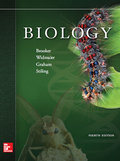
Concept explainers
Introduction: Aquaporins or water channels are the proteins that help in the movement of water across the membrane. They are integral membrane proteins that form pores in the membrane to allow the transfer of water and sometimes small solutes.
Answer to Problem 1TY
Correct answer: Aquaporins are the protein channels that allow the transfer of water across the plasma membrane. Hence, the correct answer is option c.
Explanation of Solution
Reason for correct answer:
Aquaporins are a part of major intrinsic proteins that result in the pore formation. This allow the exchange of water molecules, and in some cases, small solute particles across the plasma membrane.
Option c. is given as “a protein channel in plasma membranes that facilitates the diffusion of water”.
The intrinsic proteins that cause the exchange of water molecules across the membrane are called aquaporins. Hence, the correct answer is option c.
Reasons for the incorrect answer:
Option a. is given as, “a channel protein that allows the influx of K+ into cells, causing water to flow in between the phospholipids of the plasma membrane”.
The aquaporins only allow the transfer of water molecules from extracellular fluid to the cytoplasm and not ions. Hence, option a. is incorrect.
Option b. is given as, “a type of blue-colored pore in the epidermal surfaces of plants”.
The aquaporins are not blue colored and are present in the plasma membrane of the cells for the transport of water. Hence, option b. is incorrect.
Option d. is given as, “a transport protein, or transporter, in plasma membranes that use protons to co-transport water”.
Aquaporins are the primary channels for the transport of water, some small neutral solutes and carbon dioxide through the plant cell membrane. They transfer the water molecules based on the concentration gradient. Hence, option d. is incorrect.
Option e. is given as, “none of the above”.
The aquaporins serve as protein channels that are hydrophobic and allow the transfer of water molecules. Hence, option e. is incorrect.
Hence, the options a., b., d., and e. are incorrect.
Aquaporins are present on the plasma membrane of the plant, animal, and bacterial cells. These protein channels serve as the key transport route for the water molecules. They are hydrophobic and can also transfer some neutral solutes and carbon dioxide across the plasma membrane.
Want to see more full solutions like this?
Chapter 38 Solutions
EBK BIOLOGY
- How is a protein destined for the Endoplasmic Reticulum (ER), imported into the ER? Be concise.arrow_forwardFind out about the organisations and the movements aimed at the conservation of our natural resources. Eg Chipko movement and Greenpeace. Make a project report on such an organisation.arrow_forwardWhat are biofertilizers and mention the significancearrow_forward
- PCBs and River Otters: Otters in Washington State’s Green-Duwamish River have high levels of polychlorinated biphenyls (PCBs) in their livers. PCBs can bind to the estrogen receptors in animals and disrupt the endocrine system of these otters. The PCBs seem to increase the estrogen to androgen ratio, skewing the ratio toward too much estrogen. How would increased estrogen affect the river otter population? Based on your reading of the materials in this unit, what factors can affect fertility in humans? Explain how each of the factors affecting human fertility that you described can disrupt the human endocrine system to affect reproduction.arrow_forwardOther than oil and alcohol, are there other liquids you could compare to water (that are liquid at room temperature)? How is water unique compared to these other liquids? What follow-up experiment would you like to do, and how would you relate it to your life?arrow_forwardSelection of Traits What adaptations do scavengers have for locating and feeding on prey? What adaptations do predators have for capturing and consuming prey?arrow_forward
- Competition Between Species What natural processes limit populations from growing too large? What are some resources organisms can compete over in their natural habitat?arrow_forwardSpecies Interactions Explain how predators, prey and scavengers interact. Explain whether predators and scavengers are necessary or beneficial for an ecosystem.arrow_forwardmagine that you are conducting research on fruit type and seed dispersal. You submitted a paper to a peer-reviewed journal that addresses the factors that impact fruit type and seed dispersal mechanisms in plants of Central America. The editor of the journal communicates that your paper may be published if you make ‘minor revisions’ to the document. Describe two characteristics that you would expect in seeds that are dispersed by the wind. Contrast this with what you would expect for seeds that are gathered, buried or eaten by animals, and explain why they are different. (Editor’s note: Providing this information in your discussion will help readers to consider the significance of the research).arrow_forward
 Concepts of BiologyBiologyISBN:9781938168116Author:Samantha Fowler, Rebecca Roush, James WisePublisher:OpenStax College
Concepts of BiologyBiologyISBN:9781938168116Author:Samantha Fowler, Rebecca Roush, James WisePublisher:OpenStax College
 Biology (MindTap Course List)BiologyISBN:9781337392938Author:Eldra Solomon, Charles Martin, Diana W. Martin, Linda R. BergPublisher:Cengage Learning
Biology (MindTap Course List)BiologyISBN:9781337392938Author:Eldra Solomon, Charles Martin, Diana W. Martin, Linda R. BergPublisher:Cengage Learning Biology: The Dynamic Science (MindTap Course List)BiologyISBN:9781305389892Author:Peter J. Russell, Paul E. Hertz, Beverly McMillanPublisher:Cengage Learning
Biology: The Dynamic Science (MindTap Course List)BiologyISBN:9781305389892Author:Peter J. Russell, Paul E. Hertz, Beverly McMillanPublisher:Cengage Learning





